Vanilla has a hand in everything – ice cream, cookies, pies, cakes and even kuehs! For a long while, I was only acquainted with vanilla essence, which my mom used in her baking. My then non-inquisitive mind never did ponder about where this vanilla thing came from, until my jaunt overseas and I found out there were more expensive things called vanilla extracts and vanilla beans! Now that I’ve been exposed to vanilla extract, I doubt I can ever go back to vanilla essences – essences in our part of the world are but the poor and (fake) cousin of extracts – it is usually made of synthetic vanilla. I know that in other parts of the world, essences are a more concentrated form of extracts, but not here in Asia. Good vanilla extract is awesome – just a tiny bit is enough to elevate your baking to the next level – there is a subtle sweetness about vanilla that makes your bakes so much so aromatic.
There are many brands of vanilla extracts, but one of the more famous ones would be the Nielsen-Massey brand of vanilla extracts– which I’ve seen recommended by many sources. The good thing is that it’s available in Singapore, the bad news is that it’s rather costly (about S$20+ if I’m not wrong) as compared to the cheaper alternatives. The vanilla extract that I’m using is from Queen’s, which is somewhat of a house brand in Australia, but I find that it suits my needs for the moment.
As curious as I am with new things, I started on a research of vanilla and other related things which I’ve summarized below. I find Wikipedia useful in this area, and a simple google search will yield most informative results.
The first people to use and cultivate the vanilla bean were the Totonac Indians of Mexico – they used it in rituals, in medicine and as a perfume; but curiously, not as flavoring. When the Indians were conquered by the Aztecs in the 15th century, the secret of the vanilla bean was passed to the Aztecs, who mixed it with their chocolate to make their drink chocolatl. Following that, when the Aztecs were defeated by the Spaniard Hernando Cortez in the 16th century, he returned to Spain with vanilla and cacao, which was enjoyed only by the rich for a long time. Then in 1602, Hugh Morgan, an apothecary to Queen Elizabeth I, suggested that vanilla could be used as a flavoring by itself, and since then, the vanilla bean has been used in baking, perfume manufacture and aromatherapy.
Nowadays, most of the production and cultivation of vanilla is in Madagascar and Indonesia. Mexico, where it originally came from, only produces a small percentage of vanilla now. Another major producer is Tahiti. Vanilla beans are mainly cultivated in tropical areas – places such as Costa Rica, India, Uganda and Jamaica produce them in limited quantities.
What is it?
Vanilla beans are the dried and cured fruit from the Vanilla orchid Vanilla planifolia, a plant native to Mexico. It is the only orchid that is able to bear fruit. It is both a spice and an aromatic, and ranks second only to saffron in terms of price. Why is this so? This is because these flowers usually bloom just for a day and can only be pollinated by the Melipona bee which is native to Mexico. If the flowers are not pollinated, they wither and no beans are produced. Although it is now possible to cultivate and pollinate the flower manually, the flowers still only bloom once and the entire process is manual, including the harvesting and curing – so essentially we are paying for the high labour cost and time expended.
Characteristics of vanilla pods differ based on where and when they are cultivated. For example, Bourbon beans, which are found in Madagascar and the Bourbon Islands, have the thinnest pods of the three varieties, and are described as having a creamy and sweet flavour, with vanillin overtones. Mexican beans are similar to Bourbon beans, but have a more mellow and woody fragrance. Tahitian vanilla beans, on the other hand, come from a completely different plant variety, called vanilla tahitensis. These beans have little vanillin content, but have a fruity aroma which many favour as well.
I’ve used the terms vanilla beans and vanilla pods exchangeably, although strictly speaking, the vanilla bean refers to the pod and seeds. What we are using are the seeds contained within the pod. Each pod has an average of sixty thousand seeds!
How long do the beans remain fresh?
They should remain moist for at least a year. If they dry out, add half a potato in a jar with them to soften them for use. You can also place them in warm water before use to soften them. If you find white substance appearing on your vanilla bean, do not panic – it might not be mold – it might be the vanillin crystals which provide the vanilla bean with its intrinsic flavor. To determine whether it is mold or the crystals, just touch your finger to the bean – if it is the vanillin crystals, they will disappear after you touch them.
How should I store it?
Vanilla beans should be stored in a closed container in a cool, dry and dark place. They should not be stored in the fridge or freezer because this will dry them out. If stored in an airtight container, open the container once in a week to allow air to circulate.
How to…
Open the vanilla pod
If you are afraid of a mess, place a parchment paper below the bean such that the seeds fall on the paper instead of on your chopping board. I use a plastic cutting board, so that any stain left by the seeds/pod is easy to wash off. I use a small paring knife which helps me better control the ‘slice’.
Lay your vanilla pod on the paper (or board) and flatten them by pressing on them from top to bottom – I find that this helps in slicing the pod open. If the beans are too dry or hard, you might consider steaming them for a while. Another thing I found useful was to snip off the top end of the vanilla bean before slicing them - there are very few seeds on the extreme ends, so don’t be afraid that you are losing precious seeds! Also, leaving the other end of the bean intact helps keep the sliced open parts remain open-side up.
Scrape out the seeds
Once the pod is sliced open, you can either steep the whole bean in liquid (to impart flavor to the liquid), or scrape out the beans. Most recipes require you to scrape out the seeds so that you can add them to the batter. Using the same paring knife, flip the knife to use the blunt edge and start from the end which you did not snip off. Gently scrape the inside of the pod downwards and with slight pressure. Do not exert too much pressure because you might scrape the ‘bark’ of the pod as well. Each seed is tiny, and black, and is smaller than a needle head. All the seeds will clump together – very much like caviar. I do my scrape in sections – I scrape as much as possible from the top portion, before moving on to the other sections, all the while moving in a downward motion. Once you think you have removed all the seeds possible, do not discard the pod! This pod may still contain tiny black seeds which you can’t see, and better still – the pod itself is able to impart fragrance, aroma and flavor to other things.
PS: I haven't been able to get photos of me opening the pod and scraping out the seeds because I can't do that one-handedly and take photos :/ So that'll have to wait until I get myself a tripod!
Recipes:
To make a vanilla something, you can either use the whole pod, or just the seeds. Here's a list of Vanilla DIY projects:
For example, for Vanilla sugar, you do not need to use fresh new pods. Basically, after you have sliced the pod into half and deseeded it, use that very same pod (making sure it is clean and dry), and bury it into your jar or wherever you store your sugar. The pod will impart the vanilla flavor to your sugar. To make full use of your pod, you can run your fingers through the pod (while it is in the jar of sugar), using the sugar crystals to rub against the inside of the pod to tease out all the remaining seeds. Store the pod and sugar in an airtight container and after a short while (you can smell the difference a day later, but putting the bean in the sugar for a longer time will give you a more intense vanilla sugar), you will have your own homemade vanilla sugar!
Vanilla salt: same as for vanilla sugar, just that you place the pod in a jar of salt.
There are a few other vanilla recipes I found here – vanilla vinegar, vanilla coffee; but those aren’t my cup of tea. The main reason why I bought the vanilla beans were because I wanted to make my own vanilla ice cream (more on that next time) and because I wanted to make my own vanilla extract!
I saw a few versions of the recipe online, and I decided to do a mini experiment – one jar of vanilla extract would have the pods split, with the seeds intact, and the other would have the pods sliced and seeds scraped. There was another version which recommended cutting the pods into a few pieces, which on hindsight I think will help in releasing the pod’s fragrance more quickly. Legally, vanilla extract has to contain alcohol which is at least 35% proof, and it’s best to use flavorless alcohol – so vodka is a good choice here. Here’s the recipe I adapted and used:
Vanilla extract
Items required:
- Clean, sterilized jars or bottles
- Small paring knife
- Wooden cutting board with parchment paper OR plastic cutting board
- Alcohol (I used 40% Absolut Vodka, which is the cheapest Vodka available locally. Some recipes use rum, but I find that using vodka more preferable since it gives the vanilla a chance to shine)
Method:
- Pour a cup (or 240ml) of vodka into the sterilized or clean glass jar.
- Slice each vanilla bean lengthwise, split them in half while leaving one end connected.
- If you want to hasten the process, scrape out the seeds and put them into the jar together with the pods. Alternatively, use more vanilla beans per volume of vodka.
- Make sure the vanilla bean is completely covered with vodka and store in a dark cool, place.
- Shake the jar once in a while, otherwise you will find the dark brown color concentrated on the bottom of the jar.
- After 8 weeks, your homemade vanilla extract will be ready for use!
 |
| Sterilize your glass jars by submerging them in water and heating it to boiling point. Remove from water and let it dry before using. |
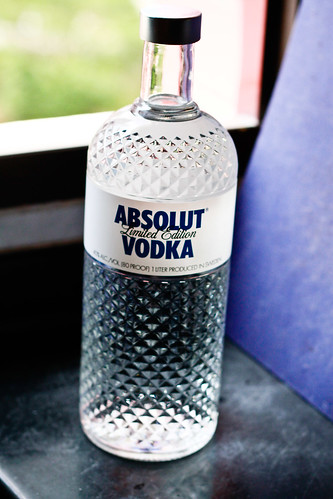 |
| I used Absolut Vodka since it was the cheapest available but you can use any flavorless alcohol with at least 35% alcohol. |
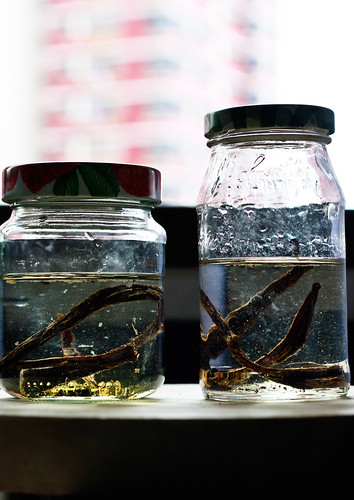 |
| Put the split vanilla beans into the jar and submerge with vodka. |
 |
| After 2 days - the colorless liquid has already turned brownish. |
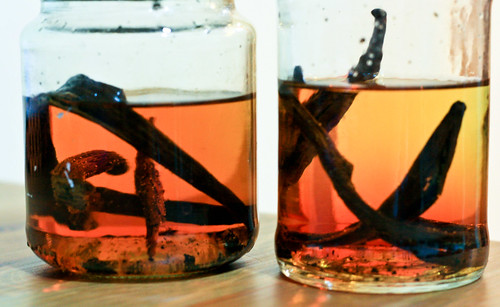 |
| I love the gradient here! Note that the jar on the right, has a lighter color than the one on the left - I suspect it is because the beans were merely split and not scraped out. |
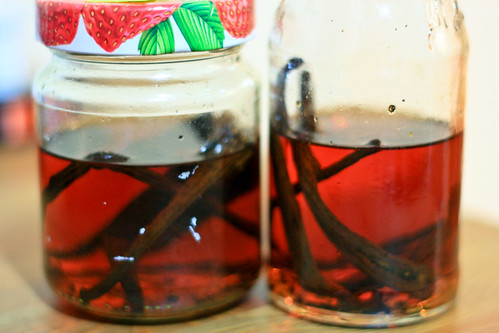 |
| 12 days have passed since I first started, and the color of the extract is deepening very nicely! |
Janine’s Jots:
- The ratio that most recipes use is 80ml for every vanilla bean, but you can reduce or increase this based on your preference. I put in 150ml of vodka for 2 split vanilla beans.
- You can replenish your extract by refilling it with more liquor, and leaving it to stand for a while before using. Also, after using a fresh bean in a recipe – for example, after scraping the seeds for a vanilla cookie, just place the empty pod into your jar. If the pod were steeped in milk or cream previously, just rinse off and dry it before placing it into the jar of extract you have going. If you continue replenishing your extract in this manner, your extract will last forever! Another tip is to remove the older beans after a while (say after a year) because they would have ‘run out’ of fragrance by then – this frees up more space for newer beans.
- If you want clean vanilla extract, be sure to use a fine sieve because otherwise you will get seeds in the extract.
- If you wish to use your extract before you reach the 8-week mark, check the flavor by putting a few drops into some milk. Drinking the extract itself is not advisable because the alcohol will overwhelm the vanilla taste whereas milk provides a good base of the flavors to develop.
- Also if you wish to replace vanilla beans in a recipe with extract, the rule of thumb is to replace a 2-inch piece of bean with 1 teaspoon of extract (tip from Rose Levy Beranbaum's book).


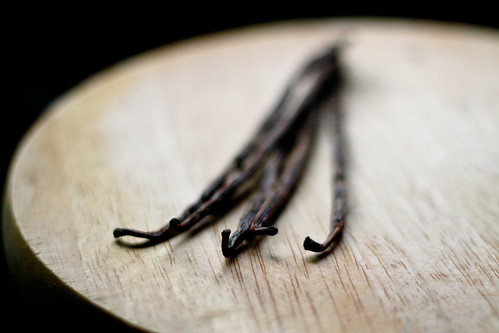
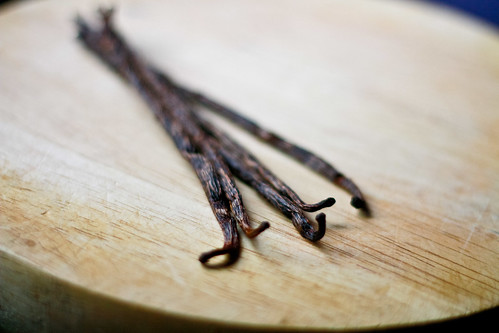
1 comment:
Hi, I just found you through The Sweetylicious. I've got some vanilla beans and vodka sitting on my shelf for months but I've yet to start on my homemade vanilla extract. Got to get my butt moving soon.
Post a Comment